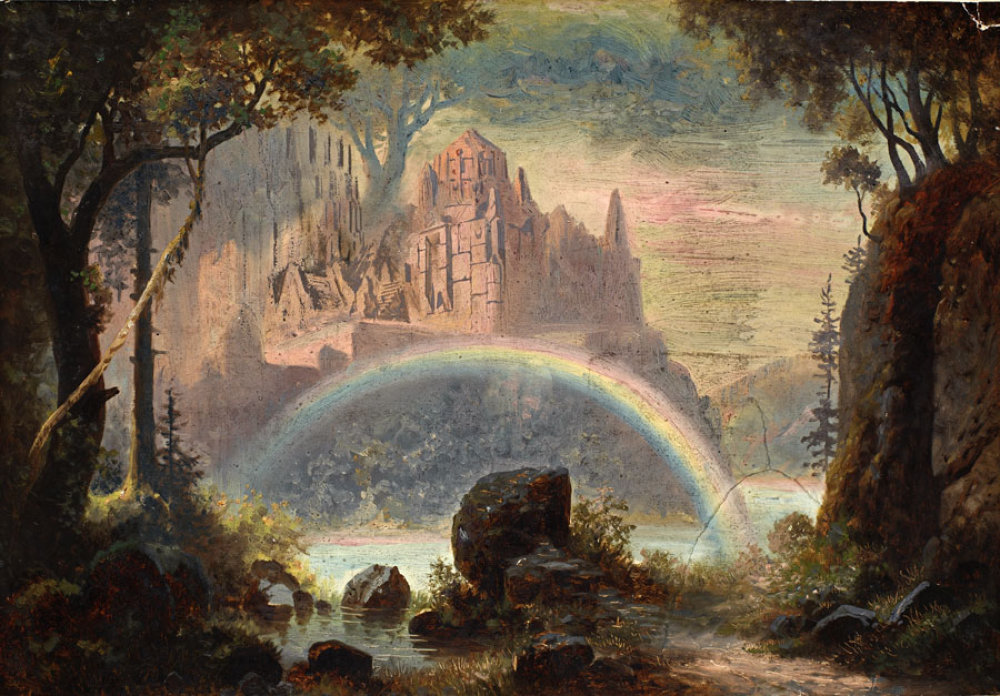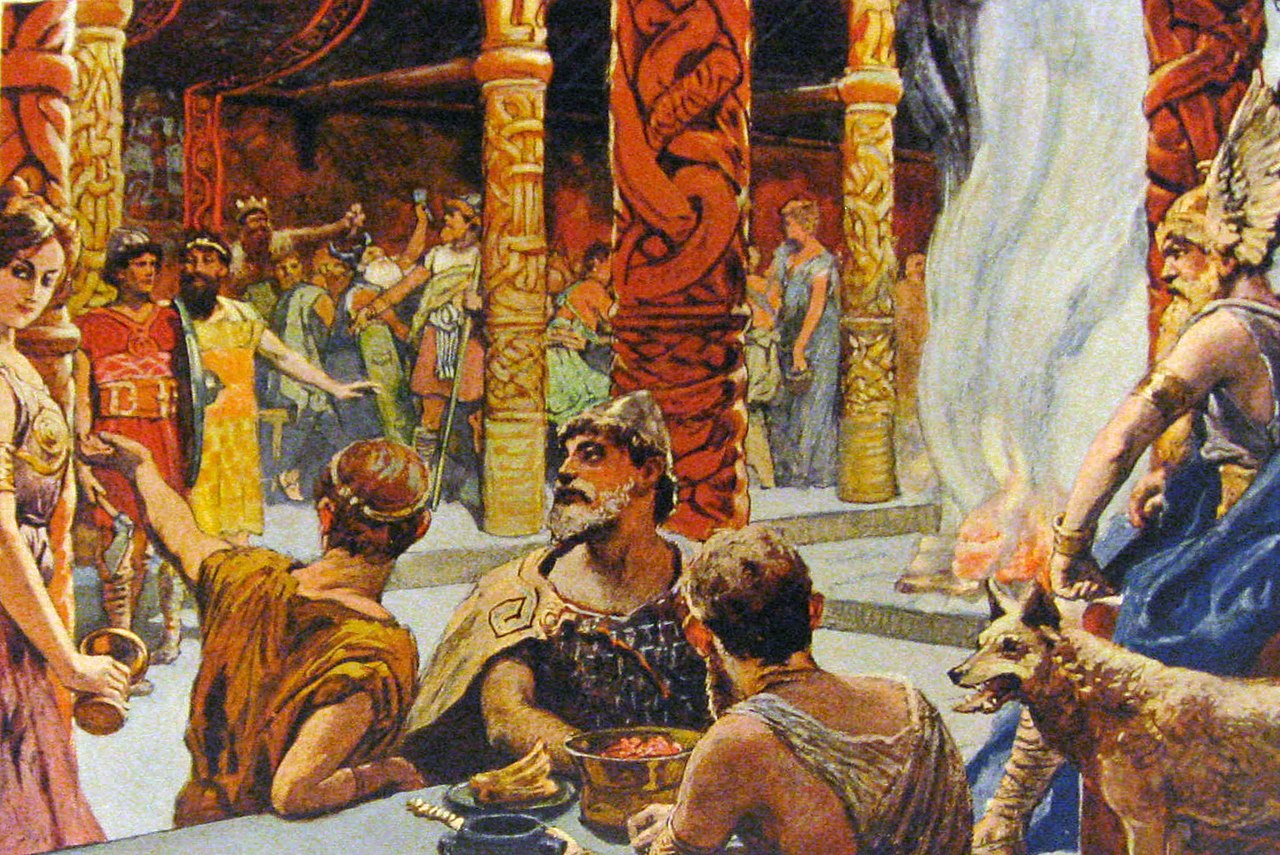A region of Asgard, Valhalla is the great hall of the slain in Norse mythology, where some warriors who have died a noble death in battle go after they are killed. Any criminal, wrongdoer, miscreant, or low life can end up in Valhalla. It is not how you live that matters; it is how you die.
Its roof is made of golden shields and is home to a giant boar reborn daily to feed the throng. The dead drink mead taken from the udders of a goat.
Odin commands an army of female horse-borne “deliverers” who carry the corpses from the battlefield to Valhalla. Although Odin is their leader, these Valkyries (or “choosers of the slain”) play an essential role in selecting warriors for Valhalla.
What is Valhalla?
Valhalla is also known as Valhöll or Valhǫll in Old Norse. “Valr” means “fallen” in Old Norse.
In Valhalla, the Einherjar warriors eat meat from the wild boar Sæhrímnir, which replenishes itself every night and the Valkyries serve them mead from the udder of the goat Heiðrún.
Becoming an Einherjar wasn’t necessarily the preserve of noble warriors. Any criminal, wrongdoer, miscreant, or low life could end up in Valhalla as an “Einherjar.” It was not how you lived that mattered; it was how you died.
Odin only wanted the best warriors to end up in Valhalla, so he would sometimes use the Valkyries to tip the balance of a fight in the inferior fighter’s favor so the more gifted one would die and become an Einheri.
The role of the Valkyries
Valkyries were the “choosers of the slain” in Old Nordic mythology. Always female and human or jötunn (giants), they were the god Odin’s appointed deliverers of brave warriors’ corpses to the great halls of the afterlife in Valhalla.
Is Valhalla and Asgard the Same?
No. According to the Skáldskaparmál in the Prose Edda by Snorri Sturluson, Asgard has several different regions, of which Valhalla is one.
Other locations are Glaðsheimr at Iðavöllr, mentioned in the Völuspá; Vinggólf for the Ásynjur (or female Norse gods); and Hlidskjálf, the high seat and vantage point of Odin.
Asgard sits in the loftiest branches of the World Tree, Yggdrasil, as the “highest” of the nine realms.

Bragi The Poet in Valhalla
Bragi was the first true skaldic poet and wrote such poignant and emotional verse that Odin named him the court poet in Valhalla after his death, believing that the finest warriors needed the finest poet and singer to tell their stories.
Did All Vikings Go to Valhalla?
There were four documented locations a Viking corpse would go after death in the Viking age:
- Valhalla (or Valhöll), the necropolis of half the Viking warriors dying a noble death in battle.
- Fólkvangr, the resting place for the other half of the fallen warriors. It was presided over by the goddess Freyja.
- Hel (or Helheim), ruled by Hel, is the underworld realm for people not dying in battle or deemed not worthy of Valhalla or Fólkvangr. Non-warrior or Valkyrie females and children went to Hel.
- The underwater domain of the giantess Ran was reserved for those dying at sea.
So Who Can Go to Valhalla?
The Einherjar
Only warriors who died a noble death in battle can go to Valhalla. The Valkyries carry them to Valhalla slung across their horses, where they feast and prepare to fight for the Æsir as part of Ragnarök. Once in Valhalla, they become known as Einherjar in Norse mythology.
Ragnarök was a succession of battles and events that preceded the end of the world. The final stage is a battle at the fields of Vígríðr that pitched gods led by Odin against demons and giants, ending in the destruction of both. Fenrir, the gigantic wolf and son of Loki, is responsible for the death of the god Odin.

Can Women go to Valhalla?
While there is no record of female warriors (or shield maidens) slain in battle going to Valhalla, this did likely happen.
Archaeological finds in burial mounds have revealed female remains lying with relics of weapons and armor next to them. Tales of shield maidens distinguishing themselves in battle survive in the 12th-century Gesta Danorum, where the author Saxo Grammaticus tells of the female warriors Lagertha and Rusla.
What Happens if a Viking Dies Without his Sword?
A sword in hand (or hammer if you were Thor!) was not a prerequisite for entering Valhalla. It all depended on how nobly you died.
Valhalla Attestations In The Prose and Poetic Eddas
Prose Edda
The Gylfaginning
The Gylfaginning is the first section of the 13th-century Prose Edda. It tells of the birth and annihilation of the world of the Æsir and many other features of Norse myths. The second and third parts are called the Skáldskaparmál and the Háttatal.
In chapter 20, Snorri Sturluson (1179-1241), the Icelandic historian, poet, and politician, claims that Odin is known as “The Father of the Fallen” because whenever his troops died under his command, they became his adopted sons. He sent them to Valhalla or Vingólf, a house of gods and goddesses.
In chapter 38, the legendary Swedish king Gangleri (sometimes an alias for Odin) mentions that if every fallen hero went to Valhalla, it had to be full of great warriors. Hárr (possibly Odin in disguise) replied that there was indeed a multitude and that many more would arrive.
In chapter 41, Gangleri asked Hárr what the Einherjar did every day in Valhalla. He replied that they put on their battledress and armor and fought each other in the courtyards.
In chapter 42, Valhalla is mentioned when we discover the origins of Odin’s horse, the eight-legged Sleipnir. Hárr is talking to Gangleri (King Gylfi in disguise) and tells him a story about an unnamed builder who offered to construct a wall around Asgard. Hárr mentions this tale unfolded when the gods built Midgard and Val-Hall (another name for Valhalla).
Skáldskaparmál
In chapter 34 of Skáldskaparmál, Bragi, the Skald mentions a grove called Glasir in front of Valhalla’s doors:
Why is gold called the Needles, or Leaves; of Glasir? In Ásgard, before the gates of Valhall, there stands a grove which is called Glasir, and its leafage is all red gold, even as is sung here:
Glasir stands
With golden leafage
Before the High God’s halls [Valhalla].Far and wide, this tree is the fairest known among gods and men.
Glasir – Pantheon Org
Poetic Edda
Grímnismál
The Grímnismál is a mythological poem in the Poetic Edda, narrated by a character called Grímnir, one of the many aliases of Odin.
It states,
For the final battle of Ragnarök, eight hundred Einherjar will march to battle [each] from the 540 doors of Valhalla.
Einherjar – Pantheon Org
Eiríksmál
The poem Eiríksmál refers to Bragi asking Odin how he could be sure the rumors of the dead Norwegian king Eric Bloodaxe coming to visit Valhalla were true.
Hákonarmál
Odin sents Bragi and Hermóðr to meet Hákon, king of Norway, who the Valkyrie Göndul had taken to Valhalla.
‘Til Valhalla Meaning
Originating from Norse mythology, ‘Til Valhalla‘ is the abbreviated form of ‘until Valhalla.’
U.S. service members say it to mean ‘until we meet again in Valhalla,’ which is another way of saying ‘until our death.‘
Assassin’s Creed
The penultimate Assassin’s Creed video game is set in Valhalla. It was released in 2020 and occupies the sixth place in the AC ‘pantheon.’

